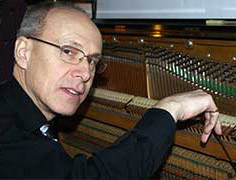So You Want a Piano...
The first and foremost advice I can give you in selecting a piano is to get a piano tuner to help you. All too often, people buy an instrument and then call the piano tuner expecting him to put right all its shortfalls. It is much better to choose a piano without those shortfalls in the first place. All tuners will happily advise you on the pitfalls of piano purchasing and will go and inspect an instrument before you part with your money. Even if you are given the instrument for free, please get it checked out as the costs of moving a piano are not cheap, and disposing of a useless piano is difficult.
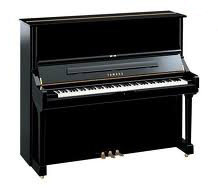 When I say get a piano tuner to check your potential purchase out, that is exactly what I mean. Don’t just take someone who can play to advise you, or a piano teacher – if you were buying a car, the person to advise you is a mechanic not a driving instructor! This is a good idea whether you are buying a new or second-hand instrument.
When I say get a piano tuner to check your potential purchase out, that is exactly what I mean. Don’t just take someone who can play to advise you, or a piano teacher – if you were buying a car, the person to advise you is a mechanic not a driving instructor! This is a good idea whether you are buying a new or second-hand instrument.
There are, of course many different kinds and styles of piano. There are uprights, and mini pianos (also a kind of upright) and there are grand pianos of various sizes. Terms such as “baby grand” are marketing terms used by some piano makers and can mean different things to different manufacturers. Generally speaking, the larger the piano, the better sound it should produce, but a 9 foot concert grand doesn’t fit in most living rooms and would probably be far too loud if it did.
In most domestic situations, there is only space for an upright. There are several different kinds.
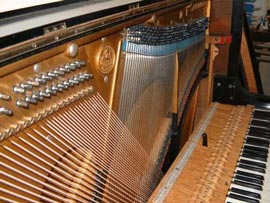
over-strung (action removed)
A modern upright is over-strung and under-damped. Over-strung means the bass strings cross over the other strings to run diagonally from top left to bottom right of the piano, thus gaining maximum string length for the size of piano. This improves tone in the bass. In an under-damped instrument the dampers, which are felt pads that lift and then press on the strings to stop the sound, are below the level of the hammers where they work more efficiently. All post-war and many pre-war upright pianos are over-strung and under-damped.
Older uprights may be straight-strung, meaning the strings are all parallel and run top to bottom. The tone is not usually as good. They may also be over-damped, which means the damping mechanism is above the hammers and nearer the ends of the strings. This is usually less efficient. You can tell if a piano is over-damped by looking inside at the action. On an over-damped piano, the top of the action is a wooden bar with the dampers screwed to it and wires running down in front to near the keys. It is sometimes nicknamed a birdcage action as the damper wires look like the bars of a cage.
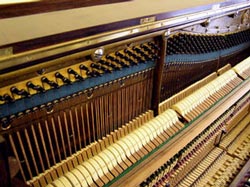
straight strung
A piano which is straight-strung and/or over-damped has a much lower value. This is not to say that all over-strung, under-damped pianos are good, and all straight-strung, over-damped ones are bad. The crucial thing with a second-hand instrument is the condition, not how it was made or even who made it. Even with a good make, if the action is heavily worn or the tuning has become unstable repair may not be financially viable.
A mini-piano is a very low upright with the keyboard very near or even at the top of the instrument. The action is hung on wires from the keys instead of sitting directly on them. While quite ingenious, the action is rather inaccessible and therefore more expensive for even minor repairs. Acoustically they tend to be very poor as so many compromises have to be made in the design to be so small.
 A lot of people aspire to own a grand piano but, because of space limitations, only have room for a very small one. Such an instrument will have short strings and a soundboard area similar to a mini-piano which means, as I said, poor tone. If you are going to have a grand, you need to have one of at least 5 feet (measured front to back) or you would be better with an upright. Modern grands are overstrung too, in fact a straight-strung grand would be VERY old! The action is of course, rather different to that of an upright as the hammers need to strike horizontal strings instead of vertical ones. Most grands have a “roller” action, which is more complex than an upright action. It has a double escapement, which in layman’s terms means the notes will repeat faster. Of course it only repeats faster if it is properly regulated, and I think even then, the average pianist probably wouldn’t notice the difference over a well regulated upright action. Some older and smaller grands have a single lever action which is quite similar to the upright action. The repetition in one of these is no better than on an upright. Grands cost more than uprights, so if you have the money for a grand, you could possibly spend the same amount and get a really good upright.
A lot of people aspire to own a grand piano but, because of space limitations, only have room for a very small one. Such an instrument will have short strings and a soundboard area similar to a mini-piano which means, as I said, poor tone. If you are going to have a grand, you need to have one of at least 5 feet (measured front to back) or you would be better with an upright. Modern grands are overstrung too, in fact a straight-strung grand would be VERY old! The action is of course, rather different to that of an upright as the hammers need to strike horizontal strings instead of vertical ones. Most grands have a “roller” action, which is more complex than an upright action. It has a double escapement, which in layman’s terms means the notes will repeat faster. Of course it only repeats faster if it is properly regulated, and I think even then, the average pianist probably wouldn’t notice the difference over a well regulated upright action. Some older and smaller grands have a single lever action which is quite similar to the upright action. The repetition in one of these is no better than on an upright. Grands cost more than uprights, so if you have the money for a grand, you could possibly spend the same amount and get a really good upright.
Take your time choosing a piano, and don’t rush to buy the first one you see. It is an investment for the future – most pianos will last at least 60 years and often much longer.
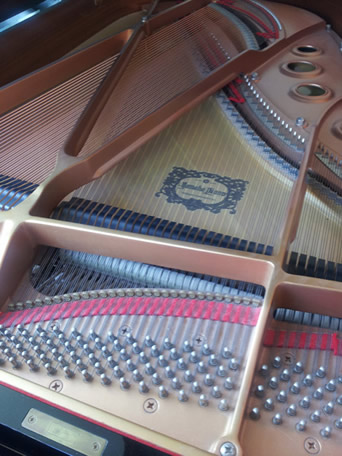
Inside a grand piano
If you are getting a piano for a child to begin lessons, don’t think you can buy a really cheap, poor quality one because it’s just for a beginner. Yes, children may seem keen for a time and then go off the piano after a while and you don’t want to have wasted too much money. I can understand that feeling, but there is a level of quality below which you really shouldn’t go. If the piano is in bad shape with notes not working properly and it not staying in tune, it will be no pleasure to play and will frustrate a learner as no matter how much they try, it will always sound bad. The instrument itself can be the reason the child quits.
Now I’m not suggesting you have to go out and buy a brand new piano for your budding pianist to start on. After all, if they do give up after a fairly short time the instrument you are left with will be second-hand if you want to sell it, and you won’t come close to getting your money back. However, because pianos have a long life, one that is already second-hand when you get it is likely still to be worth what you paid after a year or so.
If you have read this far, then you are obviously contemplating getting a piano of some description. Call me if you would like further advice, but DON’T go out and get one without getting me, or someone similarly qualified, to give it the once-over.
